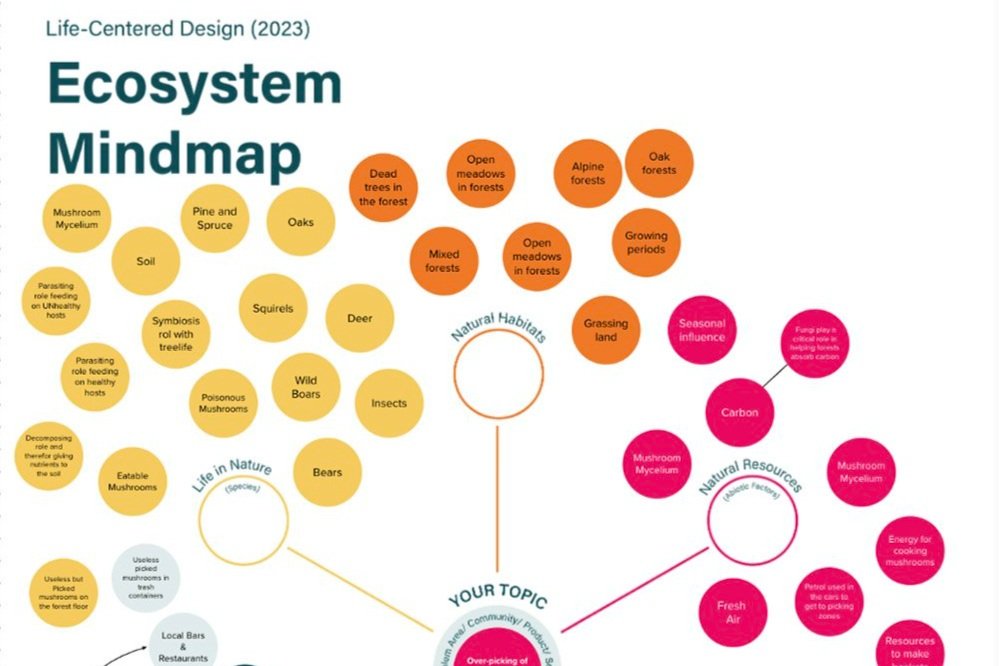LCD Weekly Issue - 008 - Design for Complexity or Simplicity?
🇺🇸 Words from Arkansas
While waiting for my breakfast in my all-American hotel in Fayetteville, Arkansas, I am looking back to a fantastic week exploring life-centred design with students and professors at the School of Arts of the University of Arkansas. These are the three ideas I take back home to the Spanish Pyrenees.
1. Put the THING in front of you
With the students from Gaby Hernandez's Design for Complexity class, we made an Ecosystem Mindmap of their water bottles. The question I asked them was:
" Do you know your water bottle?"
I had the students work in small groups. I asked them to put one of their water bottles in the middle, and together, they explored the relationships and impact of their bottle in relation to Nature, (Invisible) Communities and the Economy. Due to students having the water bottle in front of them, they learned:
What they thought was a sustainable purchase might not be so sustainable after all.
They are more aware of the amount of people and resources that are involved to get their water bottles at their doorstep.
If you are more aware of the relationships and impact of your design, you can start making different design decisions.
2. Non-human personas are fun for everyone.
The community workshop in the Ramble was attended by design students, university staff and community members without a design or creative background. After some scepticism about the anthropomorphism of nature, they committed to making a Non-Human Persona, and they presented their story of the non-human relative with a big smile, commenting:
"This is such a fun way of connecting with nature, and the way you designed the guide makes it fun for young and old."
As a designer, comments like this make me happy because the design of the non-human person guide focuses on designers and creatives, but if it works outside the creative industry, there is potential to grow our impact.-).
3. I love teaching design in real life
The last time I was teaching in front of a group of designers who make tangible & physical things was ten years ago, and I forgot how much I loved that. Teaching sustainability or social justice through a medium such as graphic design, print, or industrial design makes it much more fun, transformational and actionable. In the world of design thinking and strategy, sustainability is often kept at a conceptual level, and it is hard to see the effect of the work.
I had a fantastic week, surrounded by wonderful students and staff. Thank you for the invitation Gaby Hernandez!
🐅 LCD in the Wild - If these pants could talk
What if it was easy to shop ethically?
Imagine going shopping and chatting with the garment you want to buy. Yes, there is more than nature that you can give a voice to. Today, we present this exciting project by Peter Winter, Zoey Zhu, Jenna Fizel.
“But what if you could learn everything you wanted to know about a product just by asking it directly?
What would you ask for a pair of jeans, if these pants could talk?”
Read more about talking to non-humans, prototypes and Buck a pair of Levis501's.
🪄 Inspiration- The Feminist Designer
I haven't read the book, but she is one of the amazing professors I met during my stay at the School of Arts. Alison Place is the editor of the book The Feminist Designer, which is full of essays about feminism concerning the design space.
“Feminist design is not just about who does design—it is about how we do design and why. Feminist frameworks for design activism are now more relevant than ever, as they emphasize collaborative processes that aim to disrupt and dismantle power hierarchies while centering feminist ways of knowing and doing.”
You can get a copy here; ours is on the way!
🔥 Hot in the school- Course and Retreat
⏳ Last week to join our Shifting from Human to Life-Centered Design Online Course!
For the first time, we opened two groups: one focused on the Asia-Pacific time zones, or early CET 9-11:30 am, and the second group is our original time from 3-5:30 pm CET.
The last day to register is Monday, March 11, 2024. We have 3 spots left!
The course is 6 weeks and starts on Friday, March 15, 2024. We meet via Zoom and discover a new module each week:
Module 1: The Life-Centered Design Mindset
Module 2: Understanding The Systems of Life
Module 3: Giving Nature a Voice
Module 4: Co-Design with Life
Module 5: Bring Your Design to Life
Module 6: Design New Habits
During the course, you will work on a meaningful design project of your choice, directly applying the life-centered design attributes, such as ecosystem mind mapping, making non-human personas, and co-designing with life and regeneration.
The time to shift is now. Enroll today!
🏔️ Life-Centered Design Retreat
Enrollment is OPEN! Join us from May 19-25 for a design-changing experience! Only 5 spots are available.
We leave the rush of the design sprints behind and embark on design walks that allow you to immerse in nature and our local culture and create a deeper understanding of Life-Centered design.
Our outdoor design & coaching sessions will help you to slow down and be in the moment, which is crucial to reconnect with yourself and reflect on your design work.
During the retreat, you will work as a group on a local challenge to acquire essential Life-Centered Design skills, mindset and knowledge. You will also work individually to reflect on your career and define the next steps.
You can enroll today or book a call with us, where we will answer all your questions and go through the retreat week details.
👋 Until next Monday,
Jeroen.






